Walnut trees are cultivated not only in the gardens of India and China but also in private gardens across Europe. These trees are tall and stately, reaching heights of up to 20 m. For novice gardeners, growing a walnut tree may seem like a challenging task. In this case, experienced gardeners recommend first planting a sapling at home and then transplanting it to the garden. This article provides a detailed guide on how to grow a walnut tree at home and the agricultural techniques to follow.
Table of contents
How to Grow a Walnut Sapling at Home
Walnut saplings are low-maintenance. Healthy planting material can be obtained either from nuts or cuttings.
Each method has its own unique features and characteristics.
From a Nut
The advantage of growing a sapling from a nut is that such plants produce fewer root suckers and adapt faster to environmental conditions. Young walnut trees retain the taste and quality of the parent tree and have strong immunity.
Before planting, select and prepare the nuts, as well as suitable soil and containers.
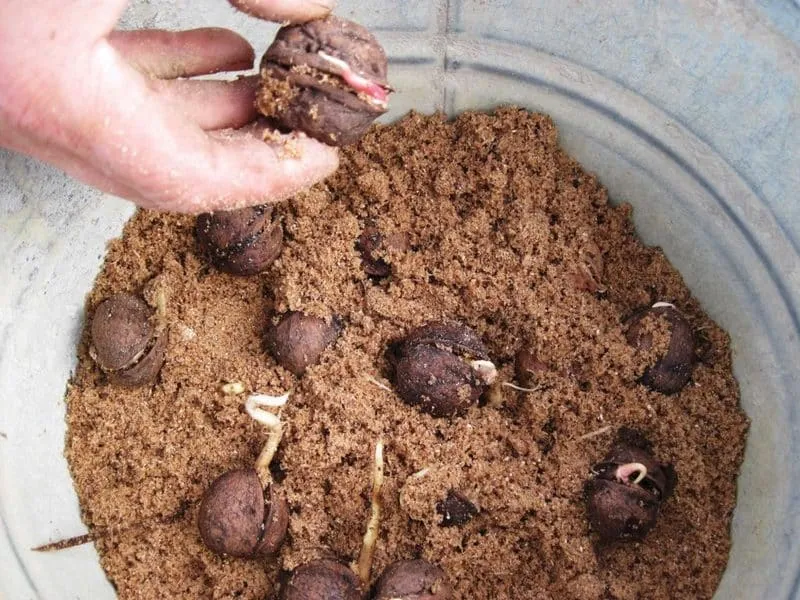
Selecting and Preparing the Planting Material
For home planting, choose firm walnuts. Taste them — they should not be bitter. For reliability, it is recommended to taste several nuts from the same tree to ensure they are all of good quality.
Pay attention to the appearance of the nuts: they should show no signs of disease, insect damage, or other defects. Cracks, breaks, or mold are also unacceptable.
Note! A suitable nut should feel heavy in the hand. If it is light, the nut is likely hollow, and growing a productive tree from it will not be possible.
Choose fresh nuts, not those from the previous year. Place them in a deep bowl and soak them in warm water with potassium permanganate. The nuts that sink to the bottom are the ones to use. Leave them to soak for 3-4 hours — this disinfects them and slightly opens the shell, stimulating sprouting.
Preparing the Soil and Container
For walnuts, prepare a deep container: a basin, pot, or tub with drainage holes. The diameter should be at least 30 cm; later, the plant will be transplanted into a larger pot with a diameter of 40-45 cm. Wash the container with clean water and dry it thoroughly. Then disinfect it by treating it with a potassium permanganate solution.
Choose loose, well-aerated soil. A mix of store-bought and garden soil works well — combine them in equal parts and add peat or compost. If the soil is clayey, improve it by adding compost. The drainage layer should consist of vermiculite, expanded clay, broken bricks, or fine gravel. The recommended soil pH level is 5.5-5.8.
From a Cutting
Propagation by cuttings is a vegetative method. If all planting rules are followed, the walnut tree can produce a harvest in just 3-4 years. Gardeners use both green and woody cuttings.
Selecting and Preparing the Planting Material

For planting, choose cuttings no older than 3 years. They should be healthy and firm, with no defects or damage. The diameter of the stem should not exceed 1.5 cm.
Gardeners cut branches 35-40 cm long from the parent tree. Cuttings are harvested in summer or spring, depending on the growing region and variety. Alternatively, ready-made cuttings can be purchased from garden nurseries.
Store the cuttings in a container with moist sand in a dark, well-ventilated place at a temperature between 0°C and +5°C. Spray them occasionally with water to prevent drying out, but avoid overwatering — excess moisture can lead to disease.
Note! Use the same soil for cuttings as for nuts. The choice of pot depends on the length and thickness of the cutting. Remember that it will grow, so select a spacious and deep container.
Timing and Rooting Process
For rooting cuttings, use a jar of water. Place the branches in the container and leave them in a warm place for a month. Change the water every 2-3 days. The air temperature for rooting should be at least +20°C, and drafts should be avoided, especially if planting in winter or autumn. During rooting, the plant's immunity strengthens, making the walnut tree more resistant to external factors.
Alternatively, use pots with soil for rooting. Fertilize the planting soil, insert the cuttings, and cover them with plastic bottles or polyethylene. After a month, the first leaves will appear, followed by roots in another 2 weeks.
How to Plant a Walnut Tree in the Garden
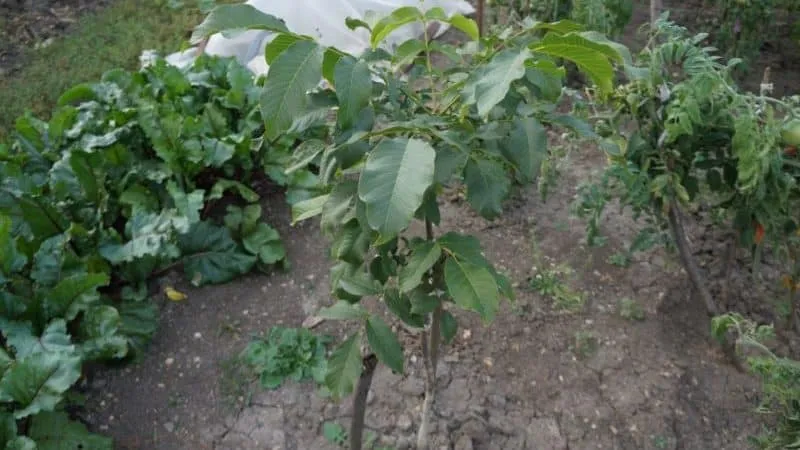
Once sprouts emerge from the nut or cutting, transplant the plant into open ground in the garden. Prepare the planting site in advance.
Walnut trees dislike cramped spaces and dense plantings, so choose a spacious, well-lit location. The soil should be sandy loam, loose, and fertile. Waterlogged soils are unsuitable — the plant will be prone to disease.
Leave at least 5 m between saplings. Suitable neighbors include berry bushes, herbs, and flower beds. Avoid planting walnut trees near other fruit trees — such as apple, pear, plum, or apricot (except for other walnut varieties).
Note! Plant walnuts in spring or autumn (late April to mid-May or early October). There is no consensus on the best planting time — gardeners adjust based on local climate conditions.
Step-by-Step Instructions
Prepare the planting hole 1-2 months in advance. Fill it halfway with planting soil and add 300 g of ash and 300 g of manure.
Follow these planting steps:
- Lay down a thick plastic sheet to encourage lateral root growth rather than deep rooting.
- Place a wooden stake nearby for support.
- Gently spread the side roots and cover them with loose soil.
- Tie the tree to the stake and water generously with settled water.
- Lightly compact the soil around the base, leaving a small mound.
Walnut Tree Care in the Garden
To ensure a bountiful harvest, walnut trees require regular care.
Young plants need frequent watering, while mature trees require pruning and protection from pests and rodents.
Caring for a Young Sapling After Planting
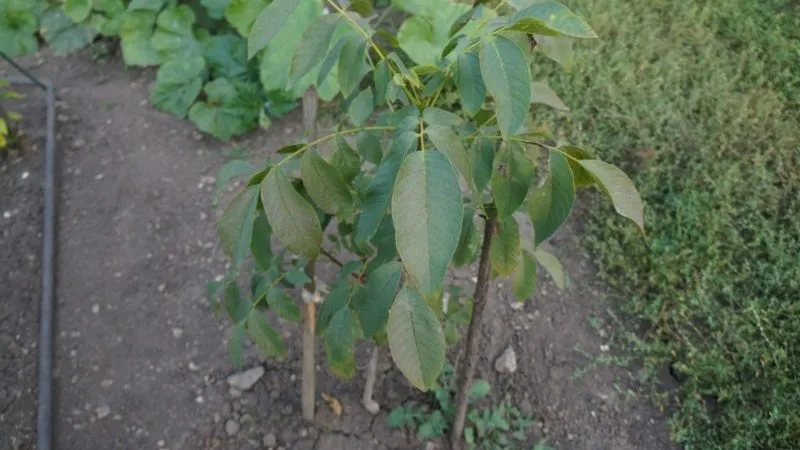
The plant loves moisture, so water it generously and frequently. On average, one tree requires 3-5 buckets of water. Before watering, loosen the soil and remove debris, creating small watering holes.
If organic and mineral fertilizers (ash, compost, vermicompost, superphosphate, or complex fertilizers) were added during planting, no additional feeding is needed for the next 2-3 years. Excess nutrients can harm young plants — they may grow quickly but produce lower-quality and smaller yields.
Note! Walnut trees need extra moisture from late spring to mid-autumn. After watering, mulch with sawdust or leaves to retain soil moisture, promoting healthy growth.
Prune the tree one year after planting. The goal is to shape the crown properly, which affects both yield and appearance. A dense crown attracts pests and diseases. Leave one main branch and pinch the rest. Also, remove young green shoots.
Caring for a Mature Tree
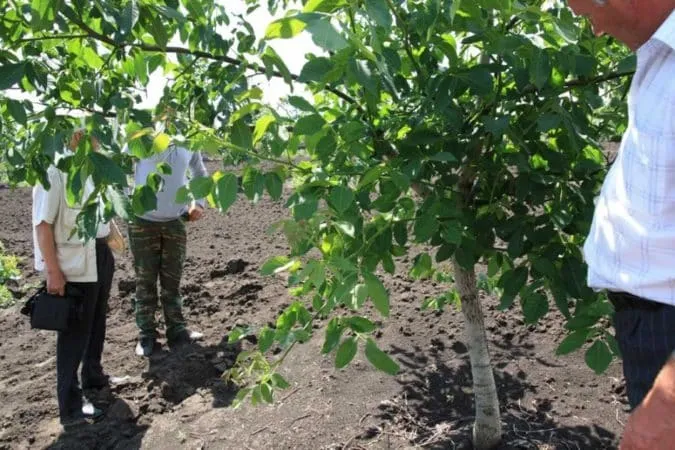
After 3-4 years, start fertilizing the walnut tree. In early summer, apply ammonium nitrate — about 6 kg per square meter. In late June, use organic fertilizers to boost fruiting and root strength, such as manure or peat (3-6 kg per tree). For trees over 20 years old, use a mix of 10 kg superphosphate and 2 kg potassium salt.
Compost made from walnut leaves is popular among gardeners. To prepare it, layer the leaves in a compost pit, water them, and add nitrogen fertilizer (30 g nitrogen per 10 L water). Leave it over winter, then mix and moisten again in spring.
After 6-7 years, prune the tree annually in early spring. Use garden shears or a saw for thick branches. Remove all dry and damaged branches, as they bear no fruit and drain nutrients. Make diagonal cuts and treat them with pruning sealant for faster healing.
Growing Considerations in Different European Regions
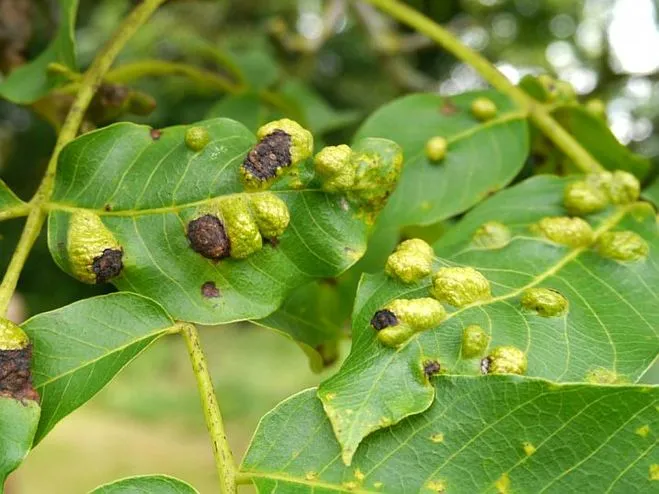
Walnut tree care varies by region. For example, gardeners in Northern Europe focus on soil aeration and weeding due to high humidity, which can cause root rot. Loosen the soil 3-5 times per season to a depth of 10 cm, increasing to 20 cm in autumn after leaf fall. Remove weeds weekly to prevent pests and diseases.
In Central and Southern Europe, ensure the tree develops only healthy, fruit-bearing branches. Keep the crown diameter under 5 m, ensuring good light exposure. Since walnut trees bear fruit late, encourage strong shoots (50 cm long, spaced 50-70 cm apart) to boost yield and airflow.
In colder regions, prioritize disease and pest control. To prevent brown spot, bacteriosis, or root canker, use a caustic soda solution (100 g per 10 L water). Inspect the tree regularly and remove affected areas. Common pests include walnut gall mites and aphids, which weaken young shoots. Control them with European-approved insecticides like Pyrethrin or Rotenone.
Note! Walnut trees cannot withstand temperatures below -28°C. When planting, choose frost-resistant varieties suited to your region.
Flowering and Fruiting of Walnut Trees
Walnut trees bloom in late April or early May, depending on the region, and bear fruit in September or October.
Walnuts weigh between 6 and 15 g, with a dark brown, sturdy shell. With proper care, a walnut tree can produce fruit for 100-200 years.
When and How It Flowers
The flowers are monoecious, appearing alongside the leaves. Both pistillate and staminate flowers grow on the same tree. Staminate flowers form pale green catkins, while pistillate flowers are round.
All walnut varieties are self-pollinating, meaning pollen transfers from male to female flowers. However, pollination can fail if the pollen is lost.
To ensure successful pollination, plant 2-3 varieties (e.g., 'Franquette', 'Lara', 'Chandler') at least 5 m apart.
Why It Might Not Fruit
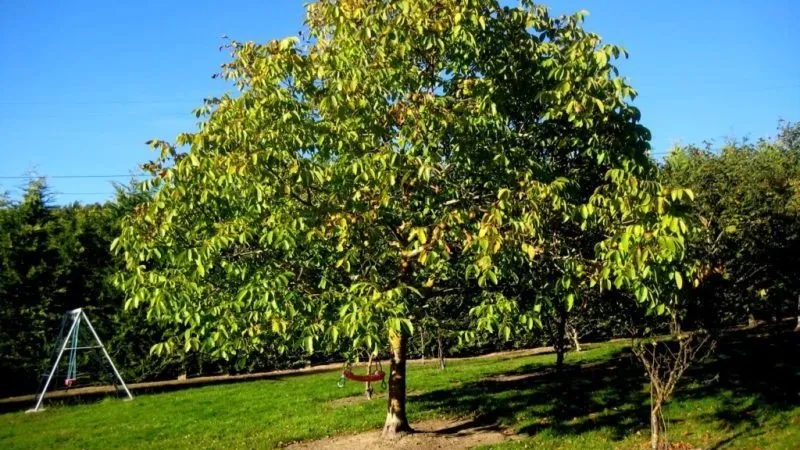
Fruiting issues often stem from poor care. A tree may yield poorly if it lacked water or nutrients between April and September. In this case, wait until next spring and maintain consistent care.
Young trees may fail to fruit due to excessive foliage. Overgrown branches shade the tree, requiring pruning, fertilizing, and mulching. Aerate the soil by lightly forking around the base.
Note! Over-fertilization can also reduce yields. If a tree grows excessively but does not flower, stop watering and fertilizing, and add washed river sand to the soil.
Conclusion
Walnut trees can be grown from nuts or cuttings. For nuts, select healthy, fresh ones, disinfect them, and soak them for a few days. For cuttings, inspect for damage or rot. Transplant saplings in spring or autumn, preparing the planting hole in advance.
Tree care involves watering, fertilizing, soil aeration, and pruning. For optimal yields, plant multiple varieties to ensure cross-pollination.







